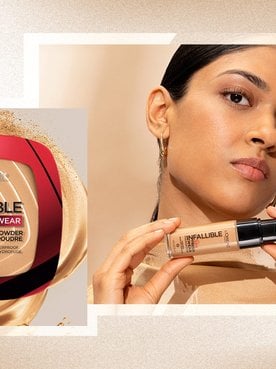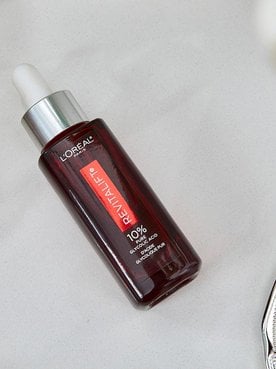Eyeshadow FAQs
What Is Eyeshadow?
Eyeshadow is an eye makeup product applied to the eyelids and under the brows to add color, depth, and dimension to the eyes. It is designed to enhance your natural beauty, making your eyes appear larger, brighter, or more dramatic, depending on the application technique and shades chosen. By using various finishes like matte or shimmer, eyeshadow can transform your look from subtle to striking.
What Are the Different Types of Eyeshadow?
Eyeshadow comes in a variety of formulations, each offering unique benefits and application styles:
•Powder Eyeshadow: Powder eyeshadow is the most common and versatile type, typically available in pressed forms. Powder eyeshadows come in a wide range of finishes, from matte to shimmer and metallic. L’Oréal Paris powder eyeshadows include Infallible Metallic Eyeshadow for a metallic finish, Infallible 24HR Eyeshadow for extreme longwear, and Colour Riche Monos Eyeshadow in matte and shimmer.
•Cream Eyeshadow: Known for its smooth, blendable texture, cream eyeshadow provides a rich, intense color payoff. It's often long-wearing and less prone to creasing than some powder formulas, making it ideal for a quick, vibrant wash of color or as a base for powder shadows to intensify their shade. Cream eyeshadow typically comes in pots, tubes, or hybrid powder-cream formulas like Infallible 24HR Eyeshadow.
•Liquid Eyeshadow: Applied with a doe-foot applicator or brush, liquid eyeshadow like Brilliant Eyes Shimmer Liquid Eyeshadow delivers a high-impact shimmer or glittery finish. It dries quickly, offering excellent longevity and minimal fallout. This type is perfect for creating striking, shimmery looks or adding a pop of sparkle.
•Stick Eyeshadow: Stick eyeshadow or eyeshadow pencils are incredibly convenient for on-the-go application. Stick eyeshadows like Paradise Le Shadow Stick offer creamy, buildable color that can be easily swiped onto the lid and blended with a finger or brush. They are often long-lasting and crease-resistant, making them a great option for quick, effortless looks or as an eyeliner.
•Gel Eyeshadow: Similar to cream shadows but often with a lighter, more translucent feel, gel eyeshadows provide a dewy or glossy finish. They can be very subtle for a natural look or built up for more intensity. Colour Riche Monos Eyeshadow is a hybrid gel-to-powder formula.
How Do I Apply Eyeshadow Correctly?
To apply eyeshadow, start by prepping your eyelids with a primer to ensure longevity and prevent creasing. This also helps colors appear more vibrant. For powder eyeshadow, flat shader brushes are great for packing color onto the lid for intense payoff, while fluffy blending brushes are essential for diffusing harsh lines and creating a seamless transition between shades.
If you’re wondering how to use eyeshadow, you can use this common technique:
1.Apply a light, neutral base shade all over the lid up to the brow bone.
2.Sweep a medium, transition shade into the crease to add depth.
3.Press a darker shade onto the outer corner for definition and blend.
Remember to choose your formula wisely: powders are versatile and easy to blend, creams and liquid eyeshadows offer intense color and longevity, while sticks provide quick, on-the-go application. Always blend, blend, blend to avoid harsh lines and achieve a professional, polished finish. Read on in our guide to learn more about how to apply makeup.
How Do I Choose the Right Eyeshadow Color for My Skin Tone?
Choosing the right eyeshadow color for your skin tone depends on not just your skin tone but also your undertone.
Eyeshadow Color for Skin Tone:
•Eyeshadow for Fair Skin Tones: For lighter complexions, softer, more delicate shades tend to be most flattering. Think pastels, light browns, champagne, light purples, and soft grays. Avoiding overly dark or stark colors can prevent them from looking too harsh against your skin.
•Eyeshadow for Medium Skin Tones: Earthy tones like bronze, olive green, warm browns, and deeper golds work wonderfully. Berry shades, coppers, and even some jewel tones can also look stunning.
•Eyeshadow Deep Skin Tones: Rich, vibrant, and highly pigmented colors truly pop on deeper complexions. Deep purples, emerald greens, cobalt blues, shimmery golds, and rich chocolate browns will stand out beautifully. Don't shy away from bold metallics either.
Eyeshadow Color for Undertone:
•Eyeshadow for Warm Undertones (veins appear greenish): Opt for eyeshadows with warm hues like gold, bronze, copper, olive, rust, and warm browns. These shades will highlight the natural warmth in your skin.
•Eyeshadow for Cool Undertones (veins appear bluish/purple): Cool-toned eyeshadows will flatter you best. Think silvers, grays, cool blues, true purples, and cool-toned browns or taupes.
•Eyeshadow for Neutral Undertones (veins appear a mix of green/blue): Lucky you! You can generally wear both warm and cool shades equally well. This allows for a great deal of versatility in your eyeshadow choices.
Ultimately, these are guidelines for how to apply natural looking eyeshadow. Don't be afraid to experiment and find what makes you feel beautiful and confident!
How Do I Make My Eyeshadow Last All Day?
To ensure your eyeshadow stays vibrant and crease-free all day, proper preparation and setting makeup are key. Begin by applying primer or nude creamy eyeshadow to your eyelids; this creates a smooth base, enhances color payoff, and grips the shadow. After applying your eyeshadow, a light mist of setting spray over your finished makeup can help lock everything in place, preventing fading and smudging throughout the day. Choosing long-wearing or waterproof eyeshadow formulas like Infallible 24HR Eyeshadow can also significantly improve wear time.
What’s the Difference Between Matte, Shimmer, and Glitter Eyeshadow?
Eyeshadows come in various finishes, each offering a unique effect:
•Matte Eyeshadow: These shades have no shine or sparkle, offering a flat, velvety finish. Matte eyeshadow shades are used for creating depth, contouring the eye, and defining the crease. Matte shadows are perfect for a sophisticated, everyday look or as a base for more elaborate styles.
•Shimmer Eyeshadow: Shimmer shadows contain fine reflective particles, giving them a subtle sheen or metallic luster. Shimmer shadows are fantastic for adding brightness and dimension to the eyelids. They are often applied on the center of the lid, the inner corner of the eye, or just under the brow bone to catch the light and make eyes appear more open.
•Glitter Eyeshadow: This finish features larger, more prominent flecks of sparkle, creating a dazzling, high-impact effect. Glitter shadows are perfect for special occasions, evening looks, or when you want a truly eye-catching pop. They can be applied as a top coat for ultimate glamour.
What Is the Most Suitable Eyeshadow Color for Daily Use?
For daily wear, neutral eyeshadow shades are your best bet, offering a polished yet understated look that complements any outfit. Think of colors like taupe, beige, soft browns, and delicate light pinks. These shades provide natural-looking definition without being overpowering.
A simple yet effective daily application involves a two-shade combination:
1.Apply a light, all-over base color (like a soft beige or light cream) across your entire eyelid up to the brow bone.
2.Then, use a slightly deeper, complementary shade (such as a soft brown or a muted taupe) in your crease to add subtle depth and dimension.
Get more ideas with our article on daytime eye makeup.
Can I Use Eyeshadow as an Eyeliner?
Yes, eyeshadow can effectively double as an eyeliner when you desire a softer, more diffused line than traditional liquid or gel liners provide. To achieve this, simply dampen a thin, angled eyeliner brush with water or a setting spray, then dip it into your chosen eyeshadow shade. Apply it along your lash line for a smudged, smoky, or more natural eyeliner look. Learn more about this technique in our guide to how to make eyeliner with eyeshadow. Alternatively, use a shadow stick like Le Shadow Stick to draw on thick, creamy lines.
How Long Does Eyeshadow Last?
How long eyeshadow lasts depends on the formula. Powder eyeshadow lasts up to two years after opening, and can last longer unopened. Cream or liquid eyeshadow, however, lasts 6 to 12 months after opening due to the liquid formula. For best results, store your eyeshadow in a cool, dry place, always use clean brushes and fingers, and close tightly after use. If you notice any changes in color, texture, or smell, it’s likely time to replace your eyeshadow.
What Kind of Eyeshadow Is Best for Mature Eyes?
Is It Better to Apply Eyeshadow with a Brush or Finger?
Brushes and fingers can both work for eyeshadow application, depending on the product and desired effect.
•Brushes offer precision and control, making them ideal for intricate looks, seamless blending, and applying powder eyeshadows. Different brush shapes are designed for specific tasks, from packing on color to diffusing harsh lines.
•Fingers, warmed by your body heat, work wonderfully for cream, liquid, and intensely pigmented shimmer/glitter eyeshadows. The warmth helps the product melt into the skin for a smooth, vibrant application and strong color payoff. However, fingers lack the precision for detailed work or fine blending.
Each application technique offers different benefits, and ultimately, whether you choose to apply eyeshadow with your brush or fingers is up to you. Always ensure your hands are clean and your brushes are regularly washed to prevent bacteria buildup and product contamination.
Should You Put Primer on Eyelids before Eyeshadow?
Yes, it can be helpful to prepare your eyelids before eyeshadow for smooth application and long-lasting wear. The best method is to use primer. A dedicated primer creates a tacky base that helps eyeshadow adhere better, intensifies color payoff, and significantly prevents creasing. Alternatively, you can use a thin layer of concealer to even out your lid tone, but ensure it's set properly to avoid creasing. After applying either primer or concealer, it's often beneficial to lightly dust a translucent powder or a neutral matte eyeshadow over your eyelid. This step creates a smooth, dry surface, making it much easier to blend powder eyeshadows seamlessly and preventing them from looking patchy. This is especially helpful if your lids tend to get oily.
How Do I Apply Eyeshadow on Hooded Eyes?
For hooded eyes, apply eyeshadow with your eyes open and be sure to use transfer-resistant and waterproof formulas. Here is a step-by-step guide to applying eyeshadow to hooded lids:
1.Prime thoroughly to prevent transfer.
2.Apply a light base shade on the eyelid.
3.Place your transition/crease color higher than your natural crease, in the visible area above the hood when your eyes are open. Blend this shade upwards towards the brow bone.
4.Apply darker shades to the outer corner, blending upwards and outwards to lift the eye.
5.Keep shimmers or bright shades on the center of the eyelid where they're most visible.
6.Consider a thin eyeliner or a soft shadow liner to avoid overwhelming the lid space.
Check out our blog article for more on how to apply eye makeup with hooded eyes.
What are the Best Eyeshadow Shades for Blue Eyes?
Blue eyes are naturally striking and tend to stand out with shades that create a beautiful contrast that makes the blue color pop:
•Oranges and Peaches: Since orange is directly opposite blue on the color wheel, shades with warm, orange undertones are incredibly effective at making blue eyes appear brighter and more intense:
•True Pinks: Pink shades add a warm, romantic look to blue eyes:
◯Rose
•Cool Tones:
For more detailed tips and to explore different looks tailored for your captivating blue eyes, dive into our comprehensive guide on makeup for blue eyes.
What Are the Best Eyeshadow Shades for Green and Hazel Eyes?
Green and hazel eyes benefit from eyeshadow shades that create a captivating contrast or capture the natural tones in these eye colors:
•Purples and Plums: Purple shades contrast nicely with the green tones in these eye colors:
•Reds: Red-toned shades are opposite green hues on the color wheel, which makes red shades complementary to green and hazel eyes:
◯Rose
•Greens: For a monochromatic effect, green eyeshadow shades complement green and hazel eyes. The trick is to choose shimmering or deeper greens:
•Browns and Golds: Earthy tones like browns and golds bring out the warmth and golden flecks often found in green and hazel eyes:
◯Gold
Remember, hazel eyes are particularly dynamic as their color can shift based on the light and surrounding colors. Experimenting with different shades will help you discover which colors truly bring out the unique facets of your eye color.
For even more inspiration and in-depth advice on selecting the perfect shades, explore this detailed guide on eye makeup for green eyes.
What Are the Best Eyeshadow Shades for Brown Eyes?
Brown eyes are very versatile and complement a wide range of eyeshadow shades, from purple to green and nearly any shade in between. If you have brown eyes, you can experiment with a wide range of eyeshadow shades. Here are some ideas to try:
•Bright Eyeshadow Shades for Brown Eyes: These brighter, more vibrant shades pair beautifully with brown eyes:
•Neutral Eyeshadow Shades for Brown Eyes: If you want a more natural eyeshadow shade, you can’t go wrong with these:
For more shade inspiration, take a look at our guide to makeup for brown eyes.
What Type of Eyeshadow Is Best for a Beginner?
For beginners, the best type of eyeshadow is typically a powder or cream formula since these types of shadows tend to be easy to apply and blend.
Pros of Powder Eyeshadows for Beginners:
•Most common eyeshadow formula
•Buildable intensity of color
•Easy to blend and is very forgiving with any application mistakes
•Flexible application: powder eyeshadows can be applied with your fingers or a brush
Pros of Cream Eyeshadows for Beginners:
•Typically available in eyeshadow stick or eyeshadow single formats
•Creamy, smooth formula is also easy to blend
•Cream eyeshadow’s dewier finish is great for a natural makeup look or a single-shade look
•Like powder eyeshadows, cream eyeshadows can also be applied with your fingers or a brush. Or, if you're using a shadow stick formula, you can swipe the cream shadow directly onto the lid and gently blend out with your ring finger.
No matter what eyeshadow you grab, practice makes perfect. Feel free to experiment with different eyeshadow formats and colors, and if you want some eyeshadow stick inspiration, check out our shadow stick tutorial.
Where Can You Buy L’Oréal Paris Eyeshadow?
You can purchase L’Oréal Paris eyeshadow makeup in several ways: at your local drugstore, large retailers, grocery chains, or online through retailers like Amazon, Target, and Ulta Beauty. Click the “Buy Online” button on the individual product pages to see where to purchase your eyeshadow online, or use our Store Locator to find an in-store option to shop for eyeshadow near you.







